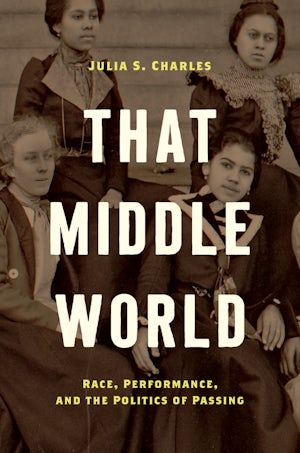The (Dis)Ability of Color; or, That Middle World: Toward A New Understanding of 19th and 20th Century Passing Narratives
University of Massachusetts, Amherst
2015
Julia S. Charles, Assistant Professor of English
Auburn University, Auburn, Alabama
This dissertation mines the intersection of racial performance and the history of the so-called “tragic mulatto” figure in American fiction. I propose that while many white writers depicted the “mulatto” character as inherently flawed because of some tainted “black blood,” many black writers’ depictions of mixed-race characters imagine solutions to the race problem. Many black writers critiqued some of America’s most egregious sins by demonstrating linkages between major shifts in American history and the mixed-race figure. Landmark legislation such as, Fugitive Slave Act 1850 and Plessy v. Ferguson (1896) are often plotlines in African American passing literature, thus demonstrating the failure of America to acknowledge its wrongdoings against people of color. While this project surveys passing narratives collectively, it pays careful consideration to those novelists whose presentations of the mixed-race figure challenge previously conceived notions of the “tragic mulatto” figure. I investigate how the writers each illuminate elements of the history of slavery and its aftermath in order to remark on black disenfranchisement at the turn of the century. Ultimately, however, I argue for the importance of the mixed-race figure as a potent symbol for imagined resolution between the larger narrative of American freedom and enslavement of blacks in the United States.
I examine several works of African American racial passing literature: William Wells Brown’s The Escape; Or, A Leap for Freedom (1858), the first published play by an African American writer. It explores the complexities of American culture at a time when tensions between North and South were about to explode into the Civil War. Running a Thousand Miles for Freedom; or, the Escape of William and Ellen Craft from Slavery (1860), tells the true story of the mixed-race Ellen Craft and her husband who escaped to freedom through various racial performances. Nella Larsen sets her novella Passing (1929) in Harlem in the 1920s. The story centers on two childhood friends reunited, but each dealing with their mixed-race ancestry in different ways. Jessie Redmon Fauset’s Plum Bun: A Novel Without a Moral (1928) and The Chinaberry Tree: A Novel of American Life (1931) and Charles W. Chesnutt’s “The Wife of His Youth” and “A Matter of Principle” (1900). endeavors to depict a better class of blacks through her examination of the fair-skinned bourgeois-striver Angela Murray. Each of these stories address American legacies of racism and representation beginning with the Civil War.
I investigate how these authors use the mixed-race figure (mostly) following the Civil War to mark the continuing impact that its legacy has had on black Americans through the New Negro Harlem Renaissance, but also to gesture to the mythic moment of freedom symbolized by successfully crossing the so-called color line. In addition to cataloguing an era of migration, the African American passing narrative represents the moment in which we shift from only seeing characters in terms of monoracial identities. These writers suggest that new performative modes of racial affiliation are necessary to achieve freedom. Reminding us that characters of mixed status practiced race in ways that enabled them to build shared identity despite an often disparate cultural heritage, these works suggest that identities like blackness are always constituted through performance. I argue that racial passing facilitated the “performance” of whiteness together with, an acknowledgment of what is accepted as blackness.
Login to read the dissertation here.
